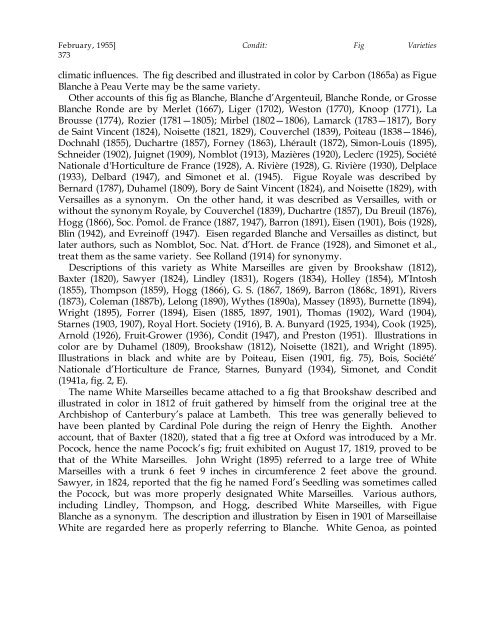Fig Varieties: A Monograph - uri=ucce.ucdavis
Fig Varieties: A Monograph - uri=ucce.ucdavis
Fig Varieties: A Monograph - uri=ucce.ucdavis
Create successful ePaper yourself
Turn your PDF publications into a flip-book with our unique Google optimized e-Paper software.
February, 1955] Condit: <strong>Fig</strong> <strong>Varieties</strong><br />
373<br />
climatic influences. The fig described and illustrated in color by Carbon (1865a) as <strong>Fig</strong>ue<br />
Blanche à Peau Verte may be the same variety.<br />
Other accounts of this fig as Blanche, Blanche d’Argenteuil, Blanche Ronde, or Grosse<br />
Blanche Ronde are by Merlet (1667), Liger (1702), Weston (1770), Knoop (1771), La<br />
Brousse (1774), Rozier (1781—1805); Mirbel (1802—1806), Lamarck (1783—1817), Bory<br />
de Saint Vincent (1824), Noisette (1821, 1829), Couverchel (1839), Poiteau (1838—1846),<br />
Dochnahl (1855), Duchartre (1857), Forney (1863), Lhérault (1872), Simon-Louis (1895),<br />
Schneider (1902), Juignet (1909), Nomblot (1913), Mazières (1920), Leclerc (1925), Société<br />
Nationale d'Horticulture de France (1928), A. Rivière (1928), G. Rivière (1930), Delplace<br />
(1933), Delbard (1947), and Simonet et al. (1945). <strong>Fig</strong>ue Royale was described by<br />
Bernard (1787), Duhamel (1809), Bory de Saint Vincent (1824), and Noisette (1829), with<br />
Versailles as a synonym. On the other hand, it was described as Versailles, with or<br />
without the synonym Royale, by Couverchel (1839), Duchartre (1857), Du Breuil (1876),<br />
Hogg (1866), Soc. Pomol. de France (1887, 1947), Barron (1891), Eisen (1901), Bois (1928),<br />
Blin (1942), and Evreinoff (1947). Eisen regarded Blanche and Versailles as distinct, but<br />
later authors, such as Nomblot, Soc. Nat. d’Hort. de France (1928), and Simonet et al.,<br />
treat them as the same variety. See Rolland (1914) for synonymy.<br />
Descriptions of this variety as White Marseilles are given by Brookshaw (1812),<br />
Baxter (1820), Sawyer (1824), Lindley (1831), Rogers (1834), Holley (1854), M’Intosh<br />
(1855), Thompson (1859), Hogg (1866), G. S. (1867, 1869), Barron (1868c, 1891), Rivers<br />
(1873), Coleman (1887b), Lelong (1890), Wythes (1890a), Massey (1893), Burnette (1894),<br />
Wright (1895), Forrer (1894), Eisen (1885, 1897, 1901), Thomas (1902), Ward (1904),<br />
Starnes (1903, 1907), Royal Hort. Society (1916), B. A. Bunyard (1925, 1934), Cook (1925),<br />
Arnold (1926), Fruit-Grower (1936), Condit (1947), and Preston (1951). Illustrations in<br />
color are by Duhamel (1809), Brookshaw (1812), Noisette (1821), and Wright (1895).<br />
Illustrations in black and white are by Poiteau, Eisen (1901, fig. 75), Bois, Société’<br />
Nationale d’Horticulture de France, Starnes, Bunyard (1934), Simonet, and Condit<br />
(1941a, fig. 2, E).<br />
The name White Marseilles became attached to a fig that Brookshaw described and<br />
illustrated in color in 1812 of fruit gathered by himself from the original tree at the<br />
Archbishop of Canterbury’s palace at Lambeth. This tree was generally believed to<br />
have been planted by Cardinal Pole during the reign of Henry the Eighth. Another<br />
account, that of Baxter (1820), stated that a fig tree at Oxford was introduced by a Mr.<br />
Pocock, hence the name Pocock’s fig; fruit exhibited on August 17, 1819, proved to be<br />
that of the White Marseilles. John Wright (1895) referred to a large tree of White<br />
Marseilles with a trunk 6 feet 9 inches in circumference 2 feet above the ground.<br />
Sawyer, in 1824, reported that the fig he named Ford’s Seedling was sometimes called<br />
the Pocock, but was more properly designated White Marseilles. Various authors,<br />
including Lindley, Thompson, and Hogg, described White Marseilles, with <strong>Fig</strong>ue<br />
Blanche as a synonym. The description and illustration by Eisen in 1901 of Marseillaise<br />
White are regarded here as properly referring to Blanche. White Genoa, as pointed















![Fig Trees in North Carolina [Archive] - IDigMyGarden ... - Figs 4 Fun](https://img.yumpu.com/26905320/1/190x245/fig-trees-in-north-carolina-archive-idigmygarden-figs-4-fun.jpg?quality=85)
